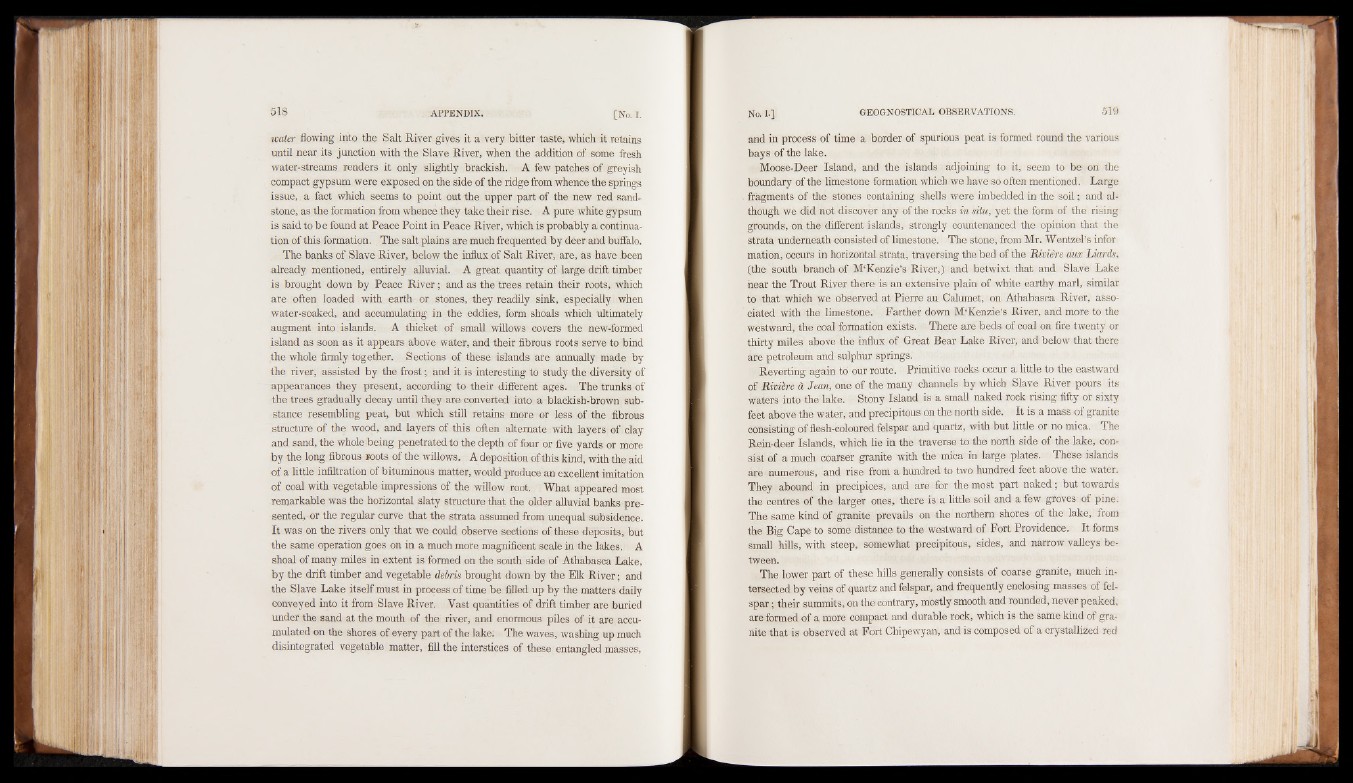
water flowing into the Salt River gives it a very bitter taste, which it retains
until near its junction with the Slave River, when the addition of some fresh
water-streams renders it only slightly brackish. A few patches of greyish
compact gypsum were exposed on the side of the ridge from whence the springs
issue, a fact which seems to point out the upper part of the new red sandstone,
as the formation from whence they take their rise. A pure white gypsum
is said to be found at Peace Point in Peace River, which is probably a continuation
of this formation. The salt plains are much frequented by deer and buffalo.
The banks of Slave River, below the influx of Salt River, are, as have been
already mentioned, entirely alluvial. A great quantity of large drift timber
is brought down by Peace River; and as the trees retain their roots, which
are often loaded with earth or stones, they readily sink, especially when
water-soaked, and accumulating in the eddies, form shoals which ultimately
augment into islands. A thicket of small willows covers the new-formed
island as soon as it appears above water, and their fibrous roots serve to bind
the whole firmly together. Sections of these islands axe annually made by
the river, assisted by the frost; and it is interesting to study the diversity of
appearances they present, according to their different ages. The trunks of
the trees gradually decay until they are converted into a blackish-brown substance
resembling peat, but which still retains more or less of the fibrous
structure of the wood, and layers of this often alternate with layers of clay
and sand, the whole being penetrated to the depth of four or five yards or more
by the long fibrous loots of the willows. A deposition of this kind, with the aid
of a little infiltration of bituminous matter, would produce an excellent imitation
of coal with vegetable impressions of the willow root. What appeared most
remarkable was the horizontal slaty structure that the older alluvial banks presented,
or the regular curve that the strata assumed from unequal subsidence.
It was on the rivers only that we could observe sections of these deposits, but
the same operation goes on in a much more magnificent scale in the lakes. A
shoal of many miles in extent is formed on the south side of Athabasca Lake,
by the drift timber and vegetable debris brought down by the Elk River; and
the Slave Lake itself must in process of time be filled up by the matters daily
conveyed into it from Slave River. Vast quantities of drift timber are buried
under the sand at the mouth of the river, and enormous piles of it are accumulated
on the shores of every part of the lake; The waves, washing up much
disintegrated vegetable matter, fill the interstices of these entangled masses,
and in process of time a border of spurious peat is formed round the various
bays of the lake.
Moose-Deer Island, and the islands adjoining to it, seem to be on the
boundary of the limestone formation which we have so often mentioned. Large
fragments of the stones containing shells were imbedded in the soil ; and although
we did not discover any of the rocks in situ, yet the form of the rising
grounds, on the different islands, strongly < countenanced the opinion that the
strata underneath consisted of limestone. The stone, from Mr. Wentzel’s infor
mation, occurs in horizontal strata, traversing the bed of the Riviere aux Liards,
(the south branch of M‘Kenzie’s River,) and betwixt that and Slave Lake
hear the Trout River there is an extensive plain of white earthy marl, similar
to that which we observed at Pierre au Calumet, on Athabasca River, associated
with the limestone. Farther down M'Kenzie’s River, and more to the
westward, the coal formation exists. There are beds of coal on fire twenty or
thirty miles above the influx of Great Bear Lake River, and below that there
are petroleum and sulphur springs.
Reverting again to our route. Primitive rocks occur a little to the eastward
of Rivière à Jean, one of the many channels by which Slave River pours its
waters into the lake. Stony Island is a small naked rock rising fifty or sixty
feet above the water, and precipitous on the north side. It is a mass of granite
consisting of flesh-coloured felspar and quartz, with but little or no mica. The
Rein-deer Islands, which lie ia the traverse to the north side of the lake, consist
of a much coarser granite with the mica in large plates. These islands
are numerous, and rise from a hundred to two hundred feet above the water.
They abound in precipices, and are for the most part naked; but towards
the centres of the larger ones, there is a little: soil and a few groves of pine.
The same kind of granite prevails on the northern shores of the lake, from
the Big Cape to some distance to the westward of Fort Providence. It forms
small hills, with steep, somewhat precipitous, sides, and narrow valleys between.
The lower part of these hills generally consists of coarse granite, much intersected
by veins of quartz and felspar, and frequently enclosing masses of felspar
; their summits, on the contrary, mostly smooth and rounded, never peaked,
are formed of a more compact and durable rock, which is the same kind of granite
that is observed at Fort Chipewyan, and is composed of a crystallized red